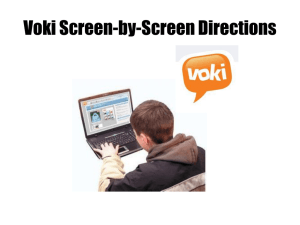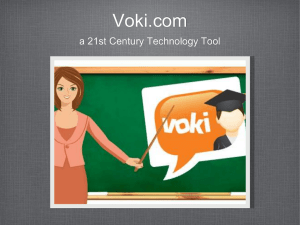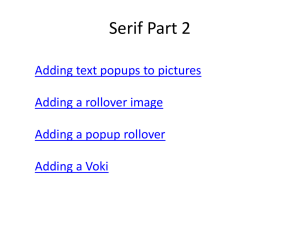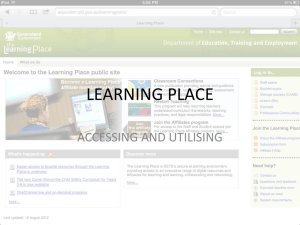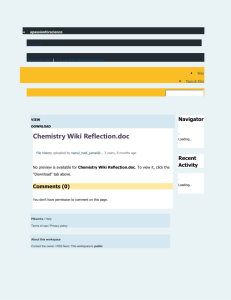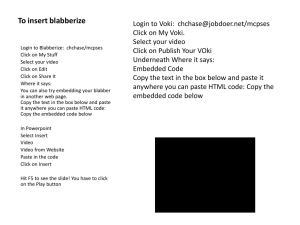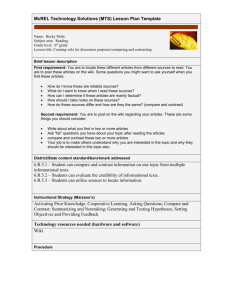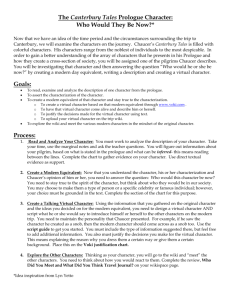Lesson Overview Summary Sheet - fall2010istc541
advertisement
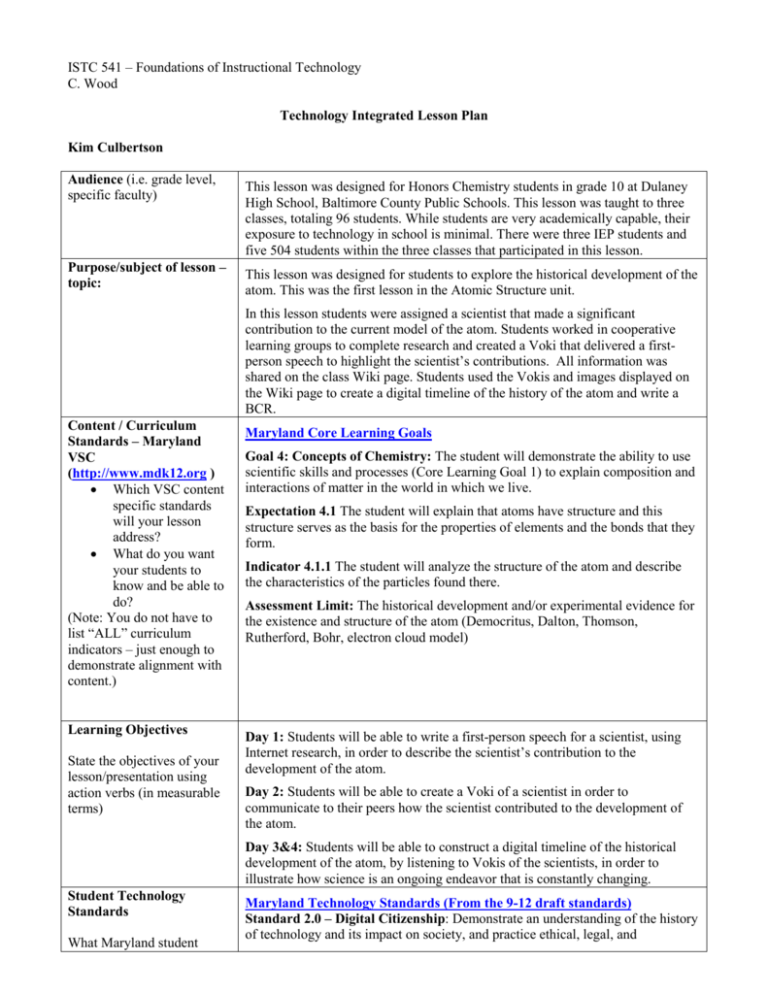
ISTC 541 – Foundations of Instructional Technology C. Wood Technology Integrated Lesson Plan Kim Culbertson Audience (i.e. grade level, specific faculty) Purpose/subject of lesson – topic: This lesson was designed for Honors Chemistry students in grade 10 at Dulaney High School, Baltimore County Public Schools. This lesson was taught to three classes, totaling 96 students. While students are very academically capable, their exposure to technology in school is minimal. There were three IEP students and five 504 students within the three classes that participated in this lesson. This lesson was designed for students to explore the historical development of the atom. This was the first lesson in the Atomic Structure unit. In this lesson students were assigned a scientist that made a significant contribution to the current model of the atom. Students worked in cooperative learning groups to complete research and created a Voki that delivered a firstperson speech to highlight the scientist’s contributions. All information was shared on the class Wiki page. Students used the Vokis and images displayed on the Wiki page to create a digital timeline of the history of the atom and write a BCR. Content / Curriculum Standards – Maryland VSC (http://www.mdk12.org ) Which VSC content specific standards will your lesson address? What do you want your students to know and be able to do? (Note: You do not have to list “ALL” curriculum indicators – just enough to demonstrate alignment with content.) Learning Objectives State the objectives of your lesson/presentation using action verbs (in measurable terms) Maryland Core Learning Goals Goal 4: Concepts of Chemistry: The student will demonstrate the ability to use scientific skills and processes (Core Learning Goal 1) to explain composition and interactions of matter in the world in which we live. Expectation 4.1 The student will explain that atoms have structure and this structure serves as the basis for the properties of elements and the bonds that they form. Indicator 4.1.1 The student will analyze the structure of the atom and describe the characteristics of the particles found there. Assessment Limit: The historical development and/or experimental evidence for the existence and structure of the atom (Democritus, Dalton, Thomson, Rutherford, Bohr, electron cloud model) Day 1: Students will be able to write a first-person speech for a scientist, using Internet research, in order to describe the scientist’s contribution to the development of the atom. Day 2: Students will be able to create a Voki of a scientist in order to communicate to their peers how the scientist contributed to the development of the atom. Day 3&4: Students will be able to construct a digital timeline of the historical development of the atom, by listening to Vokis of the scientists, in order to illustrate how science is an ongoing endeavor that is constantly changing. Student Technology Standards What Maryland student Maryland Technology Standards (From the 9-12 draft standards) Standard 2.0 – Digital Citizenship: Demonstrate an understanding of the history of technology and its impact on society, and practice ethical, legal, and technology standards are addressed in your lesson? responsible use of technology to assure safety. B. Legal and Ethical Issues 1. Practice responsible and appropriate use of technology systems, software, and information in academic, personal, and work related environments a) Understand and apply acceptable use policies and practices b) Adhere to ethical standards of conduct in the use of technology Standard 4.0 – Technology for Communication and Expression: Use technology to communicate information and express ideas using various media formats A. Communication 1. Select and use technology to communicate with diverse audiences locally and globally a) Select and use multiple media and formats to communicate information Standard 5.0 – Technology for Information Use and Management: Use technology to locate, evaluate, gather, and organize information. A. Locate, Evaluate, and Gather Information 1. Select and use information resources available through technology c) Select and evaluate information from appropriate technology resources. B. Organize information 1. Select and use technology tools to organize information a) Use appropriate technology tools to support organization of information for analysis and synthesis Teaching/Learning Theories: Describe the pedagogical model(s) you will use to present this lesson/training (i.e. projectbased learning, social constructivism, constructivism, behaviorism, blend of types, etc.) This lesson follows the Constructivist/Cognitive approach to learning. In this lesson students were given the opportunity to explore various forms of media (text, image, animation, video, talking avatars) to construct an understanding of the historical development of the atom. Students worked in social, collaborative learning groups to construct products and new ideas. This lesson was student centered and the teacher’s role was to coach students and provide a safe digital environment for students to explore and learn. Instructional Design Approaches. (n.d.). UW Departments. Retrieved December 6, 2010, from http://depts.washington.edu/eproject/Instructional%20Design%20Approaches.htm Anticipated Lesson length (i.e. one or several class periods; block of time – specify if for training) Content: Fully describe the content of your lesson. What information will be presented? How will you integrate technology into student learning? Students were given 4 45-minute class periods to complete this lesson. Students were given 1 45-minute class period to perform their research, evaluate the data collected, and create a speech for their Voki. Students will also upload related images to the Wiki page. Students were given 1 45-minute class period to modify their speech and to create a Voki that resembles the scientists that they researched. Students will also refine the images on their Wiki page. Students were given 2 45-minute class periods to listen to the Vokis and view the images on the Wiki page. Students highlighted the key points in each speech and created a digital timeline using classtools.net to illustrate the history of the atom. 1. As an engagement, students were given a black box that contained a mystery item. Students had to determine the contents of the box without being able to open/look inside the box. This demonstrated to students that the scientists that they are about to research went through the same process: trying to find out what an atom looked like without being able to see it. 2. Students were divided into seven groups and each group was assigned to a scientist. 3. Each group received a packet that contained a brief narrative of the project and a list of questions to direct their research. Each group had access to a protected Wiki page for them to type in key information, and to insert images and the Voki. Students were also given step-by-step directions for using the Wiki and Voki sites and a rubric. 4. Students first completed their research. Each group was given a fur.ly link that contained 6-8 teacher-approved websites. When doing their research, students took notes on their Wiki page and inserted relevant images. (Each group had their own Wiki page so they did not have to compete for the “lock.” 5. Students used the information compiled from their research to create a first-person speech that their scientist would give to illustrate his contribution to the development of atomic theory. 6. The speeches were edited by the teacher via the Wiki. 7. Students used their approved speeches to create a Voki. Students chose a Voki that best resembled their scientist, including facial structure, attire, and accent. Students embedded their Vokis into the Wiki. 8. The teacher put all of the individual scientist’s pages onto one class page for students to view. 9. As a class, students listened to the Vokis and viewed the images for each scientist. Students had a print version of the speeches and highlighted key information for each presentation. 10. Students individually created a timeline for the historical development of the atom using the timeline feature in classtools.net 11. As a reflection, students wrote a BCR by choosing and defending the scientist that had the greatest contribution to the development of the atom. For fun, students also voted on the Voki that best resembled the scientist. What is your rationale to support inclusion of technology in the lesson? (i.e. enrichment of content, extension of learning, student demonstration of learning) I have done this activity in the past but with the use of PowerPoint presentations and pamphlets. I heard that history teachers were using Vokis to deliver important presidential speeches and other historical information. I immediately thought that this would fit in perfectly with this assignment. In using the Voki technology, students became more engaged and ultimately created a higher quality product (in creating their speeches, students not only had to report information, but also had to evaluate it). The Vokis worked to not only deliver the content to the students, but allowed students the opportunity for creativity and expression. In addition, this lesson addressed multiple learning styles as students were able to capture the content through audio, text, and images. This also helped me achieve the “Universal Design for Learning” goal to represent information in multiple formats and media (Rose & Meyer, 2010). The Vokis were also useful to assist learning disabled students as they could listen to the Vokis as many times as they needed to and allowed for speech to text connections. Students also remarked that they listened to the Vokis when preparing for a quiz and/or benchmark instead of reading notes or the textbook. The Wiki was a great location for students to practice the 21st century learning skill of collaborative learning. Foremost, it was a safe and protected learning environment that also allowed me to easily peruse the group’s pages to formatively assess their progress and provide needed feedback. Also, it allowed groups the flexibility of working collaboratively on the project outside of class and allowed absent students the opportunity to participate as well. The use of the digital timeline allowed students to effectively synthesize ideas from this project. In this manner, students were able to clearly and concisely demonstrate their learning. Resources: Give the links for applications on the web that you will use (if appropriate). Provide links for resources for students on the web (if appropriate). Rose, D. H., & Meyer, A. (2010). Teaching every student: information and ideas. CAST. Retrieved September 9, 2010, from www.cast.org/teachingeverystudent/ideas/tes Student Links: www.voki.com Culbertson.pbworks.com Democritus & Aristotle Links: http://fur.ly/27gg John Dalton Links: http://fur.ly/24v5 J.J. Thomson Links: http://fur.ly/24ya Ernest Rutherford Links: http://fur.ly/24ye Niels Bohr Links: http://fur.ly/24yi Electron Cloud Model Links: http://fur.ly/2557 James Chadwick Links: http://fur.ly/17xd Example of student work: https://culbertson.pbworks.com/w/page/30901316/Atomic-Structure-Period-2 https://culbertson.pbworks.com/w/page/30901765/Atomic-Structure-Period-3 http://classtools.net/widgets/timeline_7/KpR1u.htm Extension: https://culbertson.pbworks.com/w/page/33648543/The-Electric-Pickle Assessment: Describe how you will assess the participants’ learning Formative: (Should occur during the lesson to give the teacher feedback on student learning). Formative (ongoing): During the project I monitored student performance by looking at the “recent changes” on my Wiki and by walking around the room and asking questions. Speeches were formatively assessed before the Voki was created to ensure the correct and appropriate information was going to be delivered. Students were assessed for their Voki and other project components with a rubric. Students were assessed for the completion of their timelines. The BCR was assessed using the 4 point HSA science rubric. Summative: (May not occur during the lesson, but is a long range goal for student learning). Attach example(s) of assessment. Summative (final): Several of the theories/scientists were tested on the county benchmark for Atomic Structure. Both multiple choice and BCR question formats were used. (Note: both categories need not be addressed, but you should provide some indication of how you will assess student learning in the lesson/unit) How do you predict the use of the technology will affect the teaching of lesson content and/or impact Before completing this lesson I predicted that the use of the Voki, Wiki and digital timeline technologies would be an effective way to combine the “legacy” content (reading, writing, history) and “future content” (the technology). Also, the project would allow me to speak to my “Digital Native” students in their language student learning? (Prensky, 2001). This is a topic that students should have learned before and I felt that introducing this technology would make the topic new and exciting for all of my students. I predicted that students would be highly intrinsically motivated to complete their research and develop a high quality summary/speech so that they could make their Voki. I also planned to show students an example of a Voki to further excite and motivate them. Prensky, M. (2001). Digital natives, digital immigrants. On the Horizon, 9(5), 16. Extension Activities Students could view the video “The Electric Pickle” and answer the question “why does the pickle turn yellow?” Students will use their knowledge of electrons, and Bohr’s model of energy orbits to deduce that the heat applied to the pickle excited the electrons to higher energy levels. When the electrons dropped back down they emitted light at a wavelength of about 570nm which is yellow on the visible spectrum. In addition, the element whose electrons are being excited is that of sodium (the salt in the pickle). Students could post their answers to a discussion page on the wiki. The teacher could perform J.J. Thomson’s cathode ray tube experiment using a Tesla coil and a zinc sulfide screen. Students would use their knowledge gained from this lesson to explain that the visible current is a flow of electrons. The teacher could further prove that electrons are negative by putting a negatively charged magnet near the beam. Students could deduce from this that the beam is negatively charged (electrons have a negative charge) because like charges repel. The students could perform a lab that is analogous to determining the location of an electron. Students will use peas and probability to deduce that the exact location of an electron cannot be determined at any given time. This template was inspired by the MTTS Standard V lesson template available at http://www.mttsonline.org
